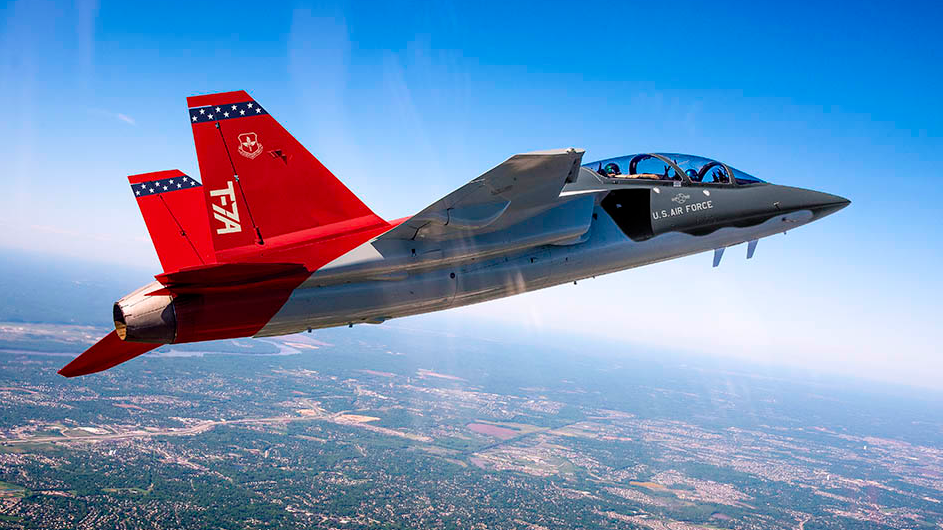
The T-7A Red Hawk, which will become the Air Force’s training jet for fighter pilots. (Boeing)
WASHINGTON: After years of deliberation on how best to train seasoned fighter pilots to combat sophisticated foes, the Air Force has now floated publicly the idea of buying more than a hundred new advanced tactical trainers. And while the service’s future trainer, the Boeing’s T-7 Red Hawk, may be in the mix, the head of Air Combat Command wants to check out the market to see whether other companies can offer a more high-performance jet.
The search officially kicked off on Oct. 12, when the Air Force issued a request for information for an “advanced tactical trainer,” which would be procured by Air Combat Command for use as an aggressor aircraft or to serve as surrogate aircraft for frontline fighter platforms, providing lower-cost follow-on training for experienced pilots.
“[The T-7] may be able to fill most of our needs. But the difference between going from ‘training’ to ‘fighter training’ would unambiguously generate a size, weight, and power requirement because we’re not just going to take off and land,” Air Combat Command head Gen. Mark Kelly said during an Oct. 25 event.
In 2018, the service awarded Boeing a $9.2 billion contract to produce at least 351 T-7A trainers for Air Education and Training Command, where they will replace the Northrop T-38 Talon used to train new fighter pilots.
ACC also operates a number of T-38s, to play the role of adversaries in training flights or to act as a surrogate trainer for aircraft like the U-2 spy plane. However, the Air Force is also interested in using trainers to accomplish some of a fighter pilot’s tactical instruction, thus freeing up frontline fighters like the F-35 and F-22 for operational missions.
That may call for the service to buy additional training aircraft. While Boeing’s contract for the T-7 includes options to buy as many as 475 planes, Kelly suggested that ACC’s requirements are different than the needs that drove AETC to purchase the Red Hawk.
Those specific ACC requirements could include more power to accommodate sensors like a radar or jammer, increased fuel capability to support longer training missions where pilots use the afterburner more frequently, the ability to use real or simulated weapons, and the integration of virtual or constructed threats.
Additionally, the Air Force hopes to buy a jet capable of flying at .9 Mach speeds — meaning that subsonic aircraft are not being ruled out — and hit at least 7.5Gs. The service could purchase at least 100 jets, with subsequent lots of 50 aircraft, the solicitation states.
“There may not be a capability gap, and there might not be anything that we need to do [to the T-7],” Kelly said. “But the flipside is, there might be other industry solutions either added to the airplane that exists now or frankly, a completely new airframe.”
Boeing, for its part, believes that the Red Hawk has the capacity to meet the Air Force’s advanced tactical trainer needs.
“From its digital beginnings, the T-7 was designed for growth,” Paul Niewald, Boeing’s vice president for T-7 programs, told Breaking Defense in a statement. “This exciting opportunity is being explored to see how the T-7’s growth path for future missions align with Air Combat Command’s ATT initiative.”
Key Competitors Lie In Wait
It’s unclear whether a program for an advanced tactical trainer will ever materialize, especially when the Air Force has a long list of weapon systems to develop and procure during a budget-constrained environment. However, responses to the request for information will help the service establish the feasibility, estimated costs, and schedule for a potential program.
While Kelly said he didn’t know when an advanced tactical trainer could become operational, the Air Force’s acquisition office “get[s] a call from me often about it.
“Every day, [the T-38] becomes just another step more disconnected from the advanced avionics, advanced sensing, the advanced processing that our modern fighters have. And so we can’t fill that void fast enough,” he said.
Interested companies were directed to respond to the Air Force’s solicitation before Nov. 23, and several aircraft manufacturers who competed against Boeing on the T-X program have already shown interest in the new opportunity.
Lockheed Martin spokeswoman Jennifer Edwards said the company is “closely reviewing the requirements for the Air Force’s Advanced Tactical Training system and developing the best solution to meet the Air Force’s future needs,” but declined to disclose whether it will put forward the supersonic T-50A it offered with Korea Aerospace Industries for the T-X contest.
Leonardo DRS — the American division of the Italian defense firm — proposed the M-346 trainer for the T- X competition and has left the door open on whether it could offer it as a tactical trainer.
“The M-346, now available also in its Fighter Attack version, offers today a wide range of opportunities to respond to [the] US Air Force requirement for an Advanced Tactical Trainer,” said spokesman Stefano Somma. “Leonardo is assessing in this phase the most suitable solution.”
Northrop Grumman, which ultimately decided not to compete for the Air Force’s T-X competition in 2018, declined to comment for this story. It remains to be seen whether the company has an ace up its sleeve for the tactical trainer requirement.






















